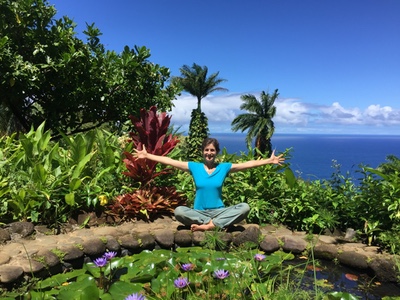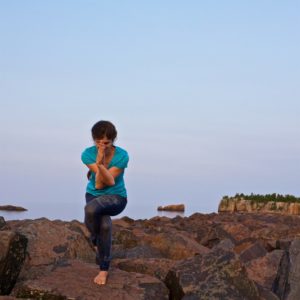
When people ask me why I moved to Maui, I have a very quick answer – for the fresh air and the lilikoi (passion fruit). It sounds funny but the thing is, it’s also very true – at least the first part.
The next question people ask is “How did you move to Maui?” My quick and somewhat glib response is “I just did.” Which is also true.
While I don’t usually write publically about my personal health concerns, today I’d like to share a longer explanation. My hope is that sharing my story will be beneficial to others with similar experiences.
For a number of years before moving to Maui, I had been suffering from fatigue and brain fog. At first I thought it was because I was working too hard, sleeping too little, and experiencing emotional stress. But it didn’t quite add up — I was eating well, moving and exercising often and had no problem falling or staying asleep (even though I wasn’t sleeping enough). My teaching and personal movement practice brought me great joy and gave me tools to cope with the day-to-day challenges but I knew my situation was not sustainable. I sought answers from my allopathic doctor. She didn’t have any suggestions, noting that all my test results were within normal range.
As the fog and fatigue progressively worsened, I decided that I needed to broadened my scope of inquiry. I began to pay close attention to when I felt healthy, strong, and alert and when my energy flagged. I immediately noticed that I felt worse on days when I spent a lot of time indoors and when I was in the presence of synthetic scents such as air fresheners and laundry detergent.
A big “aha” moment came after carpeting in a room I had been teaching in for over ten years was replaced with a tile floor. The class I taught in this room was made up of a dedicated core of students who came regularly on Friday afternoons. I loved sharing movement practices and talking story with them. Usually teaching energizes me, but I was always exhausted after this class. I had assumed I was tired because it was my last class after a long work week. My understanding of this immediately changed after the carpets were removed.
After the first class with the new floor, I did not feel tired. Instead of dreading the drive home, I wanted to go for a walk in the nearby Oakland hills. I began to reflect on my experience in that building. I had always disliked the smell of the carpet. I knew I had a sensitive nose but didn’t think that it might be an indicator of other sensitivities. I begin to suspect that something in the carpet was causing me problems.
I continued to monitor how I felt in different places. When I arrived for staff meetings at Kehilla Community Synagogue, I was usually enthusiastic and filled with ideas to share. However, after being in the building for about 20 minutes, it became harder to articulate my ideas and I felt myself lose confidence and draw inward toward self-doubt.
Once I had made these discoveries, I returned to my allopathic doctor. I am unsure about what the doctor actually thought but I felt that I had to prove that I wasn’t just making this up. Ultimately, I was diagnosed with “idiopathic chemical sensitivities” and sent on my way with no further suggestions.
At a loss about what to do, I consulted with friends in the medical field and went outside my insurance provider for a battery of blood tests. The tests revealed that I had high levels of harmful chemicals in my body and it was suggested that I follow a protocol of daily supplements. I was caught in a Catch-22: The cost of these supplements exceeded $500 a month but I was too fatigued to work more to cover the cost.
I was incredibly frustrated. My symptoms were getting worse. I had developed strange blisters on my toes, weird blots on my eyelids and had a lot of trouble getting out of bed. I was just slogging through the days hoping that things would get better but not knowing what to do. I began to suspect that along with my work place, my living environment was also affecting me. I learned that the neighbor with whom I shared some walls had mold problems. I started looking for a new place to live and considered cutting back my work load.
It was fortuitous that just around this time, my father invited me to accompany him on a vacation to Maui and I jumped at the opportunity. During this trip, I spent hours walking by the ocean and breathing the fresh air. I avoided carpeted buildings and people who wore scented products. My father obliged by changing the soap he was using. The effects of my change in environment astounded me. Within three days the blisters on my toes disappeared, the weird blots around my eyes shrunk, and my energy returned. I woke up every morning with the sun, feeling refreshed after sleeping only 7 hours.
I was so happy to be feeling healthy again that I couldn’t bear the thought of returning to live in a place where I felt so lousy. Along with renewed strength and energy, my confidence returned and ideas began to flow. I began to think, “Maybe I can find a way to spend more time in Hawaii. What would it be like to live here?” I became excited about the possibilities for my next steps in life.
One evening as these thoughts were swirling around I said to myself, “Why not? If I continue to live in an environment that’s unhealthy for me, my life is just going to get more difficult.” In a moment of confidence and excitement, I sent out a few emails and connected with a friend who had a small cottage in Upcountry Maui that was available.
Wow!
Completely changing my life now just seemed like it was the logical next step.
I went back to California, organized my things and, thanks to a dear friend, found a place to store the belongings that I was not ready to give up.
I moved to Maui not knowing what I would do or whom I would meet. I just trusted that I would have the strength and energy to build a life here.
I still don’t have a diagnosis. I suspect that I have low tolerance to mold and synthetic chemicals. As I child, I was often exposed to chemicals found in paints, fertilizers and cleansers. It is possible that this affected my resilience later in life. Although I have no evidence-based proof about the effect of chemical exposure on my health, I consider myself to be like a canary in a coal mine; I think others may be negatively affected by the chemicals swirling around but I am the first to show the symptoms.
I don’t have words to describe how fortunate I feel today. I have immense gratitude to all who have supported me in this transition. Being so far away from my family, friends, students and the wonderful communities that have long been part of my life has been challenging. One consolation is that I have found a new feathered creature with whom I feel kinship: Hawaii’s state bird, the nēnē.
Nēnē are most likely the progeny of Canadian geese who found their way to Hawaii about 500,000 years ago. Like me, they moved far away from their home and had to adapt to new surroundings. Over time, their feet changed—the webbing that covered the entirety of their feet receded and they developed three toes, which enables them to walk more easily on the lava. I, too, changed my footwear; I got rid of most of my shoes and walk barefoot much of the time. The warm weather, clean air and abundance of places to walk suits both the nēnē and me very well. Every time I see a nēnē, I smile quietly as I reflect on our commonalities.
A famous Jewish aphorism by the first century rabbi, Hillel the Elder provides the underlying answer to the question of why I moved to Maui.
If I am not for myself, who will be?
And if I am only for myself, what am I?
And if not now, then when?
With improved health, I can be more present for myself and others. As I continue to take steps into the uncertainty of my new life, I look forward to seeing how it all unfolds.



Thanks for sharing. Because I care about you, I am happy to read your story of how you are overcoming adversity in your life. We miss you in Berkeley but know you are on the right journey for you.
Awesome! Now if you can just get zvie there. . .
Good morning, Sandra!
I invite you to reframe, or expand your frame, as you think about “evidence.” You actually did have evidence of your illness and its triggers: your keen and careful observations. Often, we discount evidence that doesn’t come in the form of measurable, quantifiable, and/or replicable data. But our observations and experiences are evidence, too. Carol Gilligan is a Harvard researcher who has written extensively about gender and ways of knowing things, and is much more articulate than I am about the different kinds of knowledge and their validity.
love,
Sandy